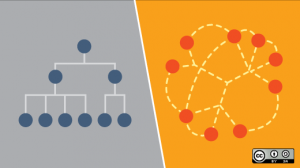We are familiar with the fact that organizations are made of networks of relationships. What we rarely try to identify is what Fritjof Capra in his book The Hidden Connection: A Science for Sustainable Living calls “boundaries of identity and interaction” and how these can influence the success or failure of our HR initiatives.
So, what are these boundaries and how can we seek to unveil them within our organizations? Lets try to analyze them from the perspective of their effects. Have you ever been in a situation in which you had to reorganize, followed all the customary procedures to define who adds more value, who less, what positions you actually need and which seem superfluous? You then implement and suddenly find that the organization has lost some key component that had not been identified and things don’t quite work as expected. Giles Hutchins, in his book “The Nature of Business” says that:
“(…) in business, it is not always obvious which parts of the organization that are not overtly adding value are merely there for the ride, or are providing a subtle benefit unmeasured by the normal performance assessment process. Cutting dead wood from an organization in challenging times may be prudent, yet damaging a useful web of stakeholder relations in times when greater resilience is needed is not prudent.”
Understanding the subtle networks of relationships that exist within an organization can be an art. We also need to understand that these relationships are not static. Like Hutchins mentions in his book, “two organisms can have many different types of relationship over time, or even at the same time.” Therefore our observation of the organization cannot be a one-time-only occurrence.
We need to establish our own networks and take every opportunity we have to observe and interact with as many people in the organization as possible and keep track of what we find. This will enable us to develop a map that overlays the organizational chart creating a picture that combines the formal and informal networks that exist. If someone moves from one position to another, that does not mean that the relationship they have with their former group ends, their influence is probably still there if there was a strong bond within the team.
Who are the people that employees mention when they are discussing examples of leadership? Who do they look to when they want to see what it takes to be successful? Who do they go to when they seek coaching? It is more frequent than not that these are not their direct managers unless they report into one of those great leaders that tend to be so few.
Who do employees identify with? Are there teams that have a strong sense of identity? What drives this cohesiveness? Is it the formal leader of the team or is there a team member that seems to be the driving force behind it? When there is a team that is viewed as a positive example, what we do to that team will also have an impact on the rest of the organization. If we eliminate it because the work they specifically do is not needed any more, what we are saying is that we do not value the principles on which this team operated. If, on the other hand, we figure out how to deploy the team to other work, we are reinforcing that this is the model we want people to immitate.
From the opposite perspective, are there teams that we have identified as being dysfunctional? What are the characteristics of the leader? What is the driver of the lack of identity? Can we identify a specific person that seems to be the disrupting factor? It has been my experience that most of dysfunctional teams lack good leaders. When I have been able to identify a team whose dynamics are negative, it normally correlates with managers that are “old school”, not on board with what the organization is now asking them to do, and frequently boycotting initiatives through sarcastic comments, or they are weak and unwilling to take charge and address the negative behavior of a team member.
A thorough knowledge of these networks, and the understanding of the organization dynamics that it provides, will provide us with vital information we need when we are developing our HR Strategy and programs. As I mentioned in “Why do HR Strategies Fail?”, we definitely also need to have a thorough understanding of the business strategy. Through our work to learn the business we can gain much of the knowledge we need and this will enable us to be attune to the subtle networks that influence what the organization can achieve.

